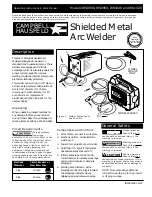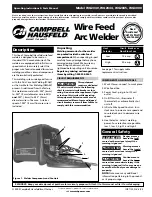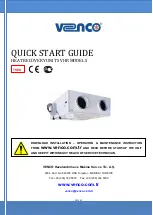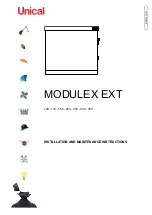
in ANSI standard #Z49.1. If ventilation is not adequate to exchange all fumes and gasses
generated during the cutting process with fresh air, do not cut unless you and all bystanders
are wearing air-supplied respirators.
•
Do not heat or cut metals coated with, or that contain, materials that produce toxic fumes
(such as galvanized steel), unless the coating is removed. Make certain the area is well
ventilated, and the operator and all bystanders are wearing air-supplied respirators.
•
Do not weld, cut, or heat lead, zinc, cadmium, mercury, beryllium, or similar metals without
seeking professional advice and inspection of the ventilation of the welding area. These
metals produce EXTREMELY TOXIC fumes that can cause discomfort, illness, and death.
•
Do not weld or cut in areas that are near chlorinated solvents. Vapors from chlorinated
hydrocarbons, such as trichloroethylene and perchloroethylene, can be decomposed by the
heat of an electric arc or its ultraviolet radiation. These actions can cause PHOSGENE, a
HIGHLY TOXIC gas to form, along with other lung and eye-irritating gasses. Do not weld or
cut where these solvent vapors can be drawn into the work area or where the ultraviolet
radiation can penetrate to areas containing even very small amounts of these vapors.
•
Do not weld or cut in a confined area unless it is being ventilated or the operator (and anyone
else in the area) is wearing an air-supplied respirator.
•
Stop cutting if you develop momentary eye, nose, or throat irritation as this indicates
inadequate ventilation. Stop work and take necessary steps to improve ventilation in the
area. Do not resume cutting if physical discomfort persists.
COMPRESSED GASSES AND AIR EQUIPMENT HAZARDS
WARNING
IMPROPER HANDLING AND MAINTENANCE OF COMPRESSED GAS
AND AIR CYLINDERS AND REGULATORS CAN RESULT IN SERIOUS
INJURY OR DEATH! To reduce risk of injury or death from compressed gas
or air and equipment hazards, read understand and follow the following safety
instructions. In addition, make certain that anyone else who uses this cutting
equipment or a bystander in the cutting area understands and follows these
safety instructions as well.
•
Do not use flammable gasses with plasma cutters. Only compressed air is suitable for plasma
cutting.
•
Do not attempt to make regulator repairs. Send faulty regulators to manufacturer’s designated
repair center for repair.
•
Do not attempt to lubricate a regulator.
•
Always immediately remove a faulty regulator from service, for repair, if any of the following
conditions exist: a.) Air leaks externally. b. Delivery pressure continues to rise with down
stream valve closed, c.) The gauge pointer does not move off the stop pin when pressurized
or fails to return to the stop pin after pressure is released.
HOT SLAG/MOLTEN METAL HAZARDS
WARNING
PLASMA ARC CUTTING CAN CAUSE SERIOUS BURNS FROM HOT SLAG OR
MOLTEN METAL! To reduce risk of injury from serious burns caused by flying or
dripping hot slag or molten metal, read understand and follow the following safety
instructions. In addition, make certain that anyone else who uses this cutting equipment
or a bystander in the cutting area understands and follows these safety instructions as
well.
•
Wear leather welding gloves, a heavy long sleeve shirt, cuffless trousers, high topped shoes,
a helmet and cap when cutting. As necessary, use additional protective clothing such as
leather jacket or sleeves, fire resistant leggings, or apron. Hot slag or molten metal can lodge
in rolled up sleeves, or trouser cuffs, and into pockets. Sleeves and collars should be kept
buttoned and pockets eliminated from the shirt front.
5
Summary of Contents for 92035
Page 20: ...REPLACEMENTPARTSLIST 20 ...
Page 24: ...24 ...






































